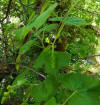|
Vitis californica Shasta Co,: near Shasta Lake, CA |
|
|
Trees and Shrubs of Kern County (Feb 2013) Key to species of Vitis in Kern County Vitis. Scandent shrubs, vines, or low shrubs with simple to forked tendrils that are opposite the leaves; bark peeling; leaves heart-shaped, alternate, lobed, indented and/or toothed along margins; flowers numerous, minute, radial, 3−4 mm, in leaf-opposed scapes, generally in umbellate secondary shoots off a main axis, which is stalked (pedunculate), unisexual on different plants or mixed bisexual and unisexual on the same plant, 5–6 merous, calyx green, collar-like with minute tooth-like lobes (sepals) petals yellow or white or aging red, inserted on disc, distinct but fused at their to tips to form a cap, deciduous as a unit; stamens often more conspicuous, 3–9; gynoecium syncarpous, 2-carpelled, ±bilocular, superior or the ovary slightly sunken in disc. Fruit: berry in draping clusters, 2-loculed, 2–4 seeded. ± 65 spp., temperate, subtropical.
1.
Flowers all bisexual; skin of fruit easily separated from pulp; leaves
1.
Flowers male and bisexual; skin of fruit not easily separable from pulp;
Young stems hairy, balding with age; undersurface of young leaves
Young stems densely hairy, not balding with age; undersurface of Vitis californica Bentham 1844. California wild grape. Deciduous woody vines; stems climbing up shrubs or trees by their branched tendrils, to 25 m, or trailing on barren ground to 5 m; leaves (blades) heart-shaped, 3–15 cm across on petioles 2.5–13 cm, somewhat limp, deeply to shallowly notched at base, palmately 3–5 veined with white cobwebby hairs mostly on the undersurface when young, balding with age. Flowers May–Jul, numerous in branched elongate scapes to 15 cm, greenish yellow, petals 5, pedicels warty, berry purplish with whitish bloom (glaucous), 6–10 mm (>8 mm if 4-seeded); seeds ~4 mm, spherical. Often covering trees near streams, springs, canyons below 4,000 ft, mixed evergreen forest, oak woodlands, Coast Ranges from San Luis Obispo to Siskiyou County, Central Valley and Sierra Nevada from Kern Co to southern Oregon. Type from lower Sacramento River. Kern Co. “Dense colony on steep banks and oak trees in El Paso Canyon.” “Wild grape was also once abundant in Grapevine Canyon”, “and was the source of the name “The Grapevine” originally used for the old Ridge Road in Los Angeles.” Colonies were eradicated by Freeway construction. “Scarce along Kern River about one mile below the China Grade bridge in Bakersfield” (Twisselmann), western and southern foothill woodland, Sierra Nevada, Transverse Ranges, and Tehachapi Mts., 126–800 m, and one report from Sand Canyon, 1,615 m (CCH). Vitis girdiana Munson 1887. Desert wild-grape. Deciduous woody vine; stems 2–7 m, purplish red, peeling; tendrils opposing leaves for 2 successive nodes then absent or replaced by flower scapes; stipules 2, orange, triangular 2−4 mm, scarious, woolly, deciduous; leaves generally heart-shaped, unlobed to shallowly digitately 3-lobed and 3–5 veined from base, 2.5–28 cm on petioles 0.6–9 cm, densely white-woolly, with straight or crooked soft hairs, purplish and less hairy with age; flowers May–Jun, on stalked (peduncles) scapes 1.5−6 cm, male or bisexual in short branched clusters along a main axis, clusters subtended by awl-shaped bracts, green aging red; petals 6, ~ 2 mm, stamens 5−7, free, curved inward, 3−4 mm long; fruit black to purple, 1–4 seeded, 3– 6 mm or more, < 8 mm if < 4 seeded, seed 4−5 mm. Along streams in canyons below 4,000 ft, coastal sage scrub, oak woodland, Santa Barbara to San Diego County, less frequent in the desert, to Inyo Co. 3,000–6,500 ft, also Santa Catalina Is and Baja California. Type from San Diego County, CA. Kern Co.: Eastern Sierra Nevada, 914–2,072 m (CCH); “Several dense colonies grow in Grapevine Canyon in the southern Sierra Nevada north of Walker Pass” (Twisselmann); two records from the Valley at 122 m (CCH). *Vitis vinifera Linnaeus 1753. Domestic grape. Twisselmann reported a spontaneous colony on Sunset Boulevard just west of Edison Road in the Weedpatch district. CCH specimens all from vineyards.
|
|
|
|
|
